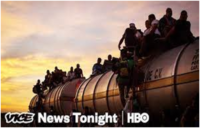Last Updated on June 19, 2022 by themigrationnews

Author: Vice News HBO.
Year: 2018
Length: Twenty-One Minutes.
Publisher: YouTube.
Motivation to Move
In the month of December 2018, a large group of people known as the ‘caravan’ is on the march to the United States, mostly from Central and South American countries. The protagonist is a sixteen-year-old boy who is going on with his life until he sees the caravan on television. He immediately tells his mum he is joining the caravan which is passing through Honduras, his country of origin in Central America. Mario Cartagena Martinez is one amongst millions on their way to the United States to live the ‘American’ dream.
What drives many like Mario Cartagena to take the perilous journey of thousands of miles, with costly and uncertain benefits? Like any other mass migration story, the factors are related to human suffering and mass displacement. A large number of the ‘caravan’ are from regions of the world experiencing conflicts such as Yemen, Sub-Saharan African countries like Ethiopia, and the political refugees from Asia. Political refugees also include members of the LGBTQ+ community who are shunned in many parts of the world.
Human traffickers and drug smugglers have utilized the path of the ‘caravan’ for decades. A boom in human smuggling has occurred from Central America through Mexico to the United States. The human smugglers linked to drug cartels converge with most of their South American and international victims in Honduras through ship or plane. They then start their land route through Honduras, Guatemala, and finally Mexico before reaching the United States border, where only a few will make it through the irregular pathway, which is heavily guarded.
The majority of the immigrants are Central Americans from Honduras, El Salvador, and Guatemala. They have been victims of America’s war on drugs from the onset of the Ronald Reagan era, which continues to date. Central American countries are a key shipping and smuggling point of drugs to the States. Collaborative countries enroute have hosted stopping and loading points for drug cartels, be it on air or ship. This has resulted in gangs and politically led proxy wars in these countries that have displaced thousands and resulted in the highest global death rates (VOX, 2019).
The Caravan on the Move
Mario Martinez starts his journey with the psychological perception of a better life in the States as a student and future graduate. He intends to send remittances to his six siblings once well settled in the United States. The lad walks with the migrating crowd from dawn to dusk, eating and resting in the towns of Honduras. An economy is created as necessities such as food, clothing, and bodily cleaning requirements are purchased. Local authorities are on high alert as almost a million individuals cross their towns and rest on their streets.
The’ caravan’ turns one river into a bathing spot, and the sheer numbers can be compared to ancient migrations. The picture of the countless on a train is compared to the millions forced to migrate as a consequence of the India-Pakistan partition. Mario Martinez and the ‘caravan’ are guests of various refugee as well as religious organizations. In my opinion, this is controversial as it encourages irregular and dangerous pathways. One notable organization is the church of Nazareno, which offers food and an ironic encouragement to get to the border.
This begs the question; where is the International Organization for Migration? Where are the various human rights organizations, such as the United Nations Human Rights Council? These organizations and states should divert traffic and incorporate the assessed vulnerable into their database and facilitate effective resettlement. All this occurred in front of the world and was covered for weeks by the media, and yet the ‘caravan’ was encouraged to continue this irregular pathway.
The Mexican authorities play an important role in the irregular migration as the largest part of the journey occurs in Mexico. However, their efforts are focused on the border with the United States. A religious rally boosts the hearts of the ‘caravan,’ and I believe intoxicates many, thus further risking safe migration. In Mexico, we see a different phenomenon of a helping hand from Mexicans and Central Americans to get further north.
In a town called Puebla, young Mario and members of the ‘caravan’ are hosted in a deportation Centre and ferried by immigration officials. The next day the journey to the United States border continues, and good Samaritans help, such as a trailer driver carrying hundreds of people. Mario Martinez is amongst the migrants who get to Tijuana, northern Mexico, which is a border town, and reunited with his uncle Olive Martinez who is seeking to cross back to the United States.
Seeking Asylum
Hundreds of thousands of individuals of the ‘caravan’ are camped in Tijuana, waiting for their documents to be processed for crossing to the United States. The world is watching events, and the United States is under pressure to halt the mass migration; thus, President Donald Trump signed an executive order to halt the ‘caravan.’ Alternatives of detention are revoked, and upon illegal crossing, one is detained, and minors seized. Minors are provided with the opportunity to be US citizens, which can occur with the consent of the parent. Minors are immediately sent to a shelter, and their kin is deported.
Some radical and armed Mexicans consider the Central American migration as an invasion and protest for their deportation from their land. Supporters of President Trump’s policy participate in the Mexico rally, and Mario Martinez sees a bleak future. Despite the challenges, Mario decides to leave with his uncle, a United States deportee who is optimistic about crossing and studying. The documentary ends with pictures of the journey, mostly of women and children, evoking the empathy of viewers, which I believe is why it won an award. The story is the depiction of a disaster created by a world power.
The war on drugs by Uncle Sam has resulted in counterinsurgency against drug cartels that has led to infighting in Central America which has displaced millions. Hence mass migration to seek a better life, and only the world powers led by Uncle Sam can aid through effective policies in these countries. Rebuilding what they helped destroy is the only solution rather than spending billions on a war on drugs that has never been won since Ronald Reagan. Global migration organizations need to develop an emergency response to avoid the same disastrous outcomes due to short-sighted policies.

Benedict Kuol is a GRDFT Global Compact for Migration graduate as well as a finance major from Strathmore University. He is a passionate upcoming writer and loves his role as a GRDFT Research Intern.
